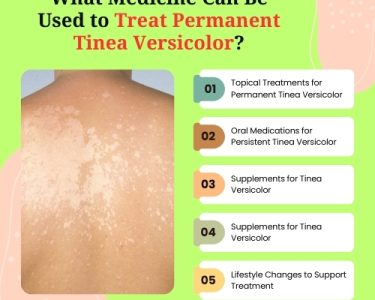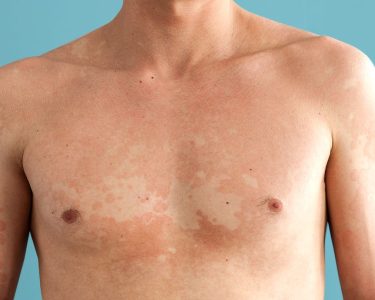When it comes to skin discoloration, two conditions often confuse people — Tinea Versicolor and Vitiligo. Both lead to patches of lighter or darker skin, but they have very different causes, symptoms, and treatments. While Tinea Versicolor is a fungal infection that temporarily alters skin color, Vitiligo is an autoimmune disorder that causes a permanent loss of pigment-producing cells.
Understanding the differences between these two skin conditions is essential for accurate diagnosis and effective treatment. Tinea Versicolor vs Vitiligo—what sets them apart, how to recognize their signs, and the best treatment options available for each.
What Is Tinea Versicolor?
Tinea Versicolor, also known as Pityriasis Versicolor, is a common superficial fungal infection caused by a type of yeast called Malassezia. This yeast naturally lives on human skin, but when it overgrows—often due to heat, humidity, or oily skin—it disrupts normal pigmentation.

Causes of Tinea Versicolor
Several factors can trigger the overgrowth of Malassezia fungus, including:
- Hot and humid environments
- Excessive sweating
- Oily skin types
- Weakened immune system
- Hormonal changes
- Use of oily lotions or creams
Symptoms of Tinea Versicolor
The most noticeable signs of Tinea Versicolor include:
- Discolored patches on the skin, which may appear lighter or darker than surrounding areas
- Commonly affected areas: chest, back, neck, and upper arms
- Mild itching, especially when sweating
- Fine scaling or flakiness on the affected patches
The patches may appear white, pink, tan, or brown, depending on the person’s skin tone and the extent of fungal growth.
Who Is Most at Risk?
Tinea Versicolor can affect anyone, but it’s more common among:
- Teenagers and young adults
- People living in tropical climates
- Individuals with oily skin
- Those with weakened immune systems
What is Vitiligo?
Vitiligo is an autoimmune skin condition where the immune system mistakenly attacks and destroys melanocytes—the cells responsible for producing melanin, the pigment that gives skin its color. This results in white or depigmented patches that can appear anywhere on the body.

Causes of Vitiligo
The exact cause of Vitiligo is still unknown, but several factors are believed to contribute:
- Autoimmune reactions: The immune system attacks pigment cells.
- Genetic predisposition: Vitiligo may run in families.
- Environmental triggers: Sunburn, stress, or chemical exposure can worsen the condition.
- Oxidative stress: An imbalance between free radicals and antioxidants in the body may play a role.
Symptoms of Vitiligo
Common signs of Vitiligo include:
- White patches on the skin that gradually increase in size
- Affected areas include the face, hands, elbows, knees, and around body openings (mouth, eyes, genitals)
- Loss of pigment in hair, eyelashes, eyebrows, or beard
- No itching or scaling, unlike Tinea Versicolor
Types of Vitiligo
Vitiligo can present in different patterns:
- Generalized Vitiligo: Widespread and symmetrical patches across the body.
- Segmental Vitiligo: Patches appear on one side or part of the body.
- Focal Vitiligo: Limited to a few small areas.
- Universal Vitiligo: Extensive depigmentation across most of the body.
Tinea Versicolor vs Vitiligo: Key Differences
While both conditions cause changes in skin pigmentation, they differ significantly in origin, appearance, symptoms, and treatment. Here’s a detailed comparison:
| Feature | Tinea Versicolor | Vitiligo |
| Cause | Fungal infection (Malassezia) | Autoimmune destruction of melanocytes |
| Type | Infectious, temporary | Non-infectious, chronic |
| Patch Color | White, tan, pink, or brown | Pure white |
| Texture | Scaly or flaky | Smooth |
| Itching | Mild itching may occur | Usually none |
| Spread | May spread with heat or sweat | Gradual and unpredictable |
| Location | Upper body, chest, back, neck | Face, hands, joints, and around openings |
| Response to Sun | Affected areas do not tan | Patches remain white even after sun exposure |
| Treatment | Antifungal medications | Medical therapies and cosmetic options |
| Recurrence | Common if not managed | Chronic but stable over time |
How to Identify the Condition
1. Examine the Patch Texture
- Scaly or flaky patches? → Likely Tinea Versicolor.
- Smooth white patches with no scaling? → Likely Vitiligo.
2. Observe the Patch Color and Edges
- Tinea Versicolor: Patches can be tan, brown, pink, or lighter than the surrounding skin with irregular borders.
- Vitiligo: Patches are completely white, often with sharply defined edges.
3. Check for Itching
Mild itching or irritation is common in Tinea Versicolor, especially in humid weather, whereas Vitiligo is typically non-itchy.
4. UV Light (Wood’s Lamp) Test
Dermatologists often use a Wood’s lamp to differentiate between the two:
- Tinea Versicolor glows a yellowish or coppery color under UV light.
- Vitiligo glows a bright white or blue-white
5. Skin Scraping or Biopsy
A dermatologist may perform a KOH (potassium hydroxide) test for Tinea Versicolor to identify fungal elements under a microscope.
For Vitiligo, a skin biopsy can confirm the loss of melanocytes.
Treatment for Tinea Versicolor
Fortunately, Tinea Versicolor is easily treatable with antifungal medications and proper skincare. However, discoloration may persist for weeks even after the fungus is gone, as skin pigment takes time to normalize.
1. Topical Antifungal Treatments
- Clotrimazole cream
- Ketoconazole shampoo or cream
- Selenium sulfide lotion
- Terbinafine cream
Apply these to affected areas as directed by your dermatologist, typically for 2 to 4 weeks.
2. Oral Antifungal Medications
For widespread or recurrent infections:
- Fluconazole or Itraconazole tablets may be prescribed.
These help eliminate fungal overgrowth from within the body.
3. Home Remedies for Tinea Versicolor
Natural Remedies for Tinea Versicolor can help manage mild cases:
- Apple cider vinegar: Apply diluted vinegar to balance skin pH.
- Tea tree oil: Possesses antifungal properties.
- Aloe vera: Soothes itching and reduces inflammation.
4. Preventive Measures
- Keep skin dry and clean.
- Avoid heavy, oily lotions.
- Wear breathable fabrics.
- Use antifungal body washes during humid weather.
Treatment for Vitiligo
Vitiligo requires long-term management, as there’s no absolute cure yet. However, several medical and cosmetic treatments can help restore color or even out skin tone.
1. Topical Treatments
- Corticosteroid creams: Reduce inflammation and encourage repigmentation.
- Calcineurin inhibitors (Tacrolimus or Pimecrolimus): Useful for facial and sensitive areas.
- Vitamin D analogs: Help regulate skin cell growth.
2. Light Therapy (Phototherapy)
- Narrowband UVB therapy: The most effective treatment for widespread Vitiligo.
- Excimer laser: Targets specific areas of depigmentation.
3. Surgical Treatments
In resistant cases, dermatologists may recommend:
- Skin grafting: Transplanting pigmented skin to white patches.
- Cellular grafting: Melanocyte transplantation.
4. Depigmentation Therapy
For extensive Vitiligo, patients may choose to lighten unaffected areas using Monobenzone for a uniform appearance.
5. Cosmetic Solutions
- Camouflage makeup: Blends patches for even skin tone.
- Self-tanning products: Offer temporary coverage.
6. Lifestyle and Emotional Support
Vitiligo can affect self-esteem. Counseling, support groups, and mindfulness practices can help patients cope emotionally.
Natural and Home Remedies for Vitiligo
Although home remedies cannot cure Vitiligo, some may support skin health and pigment balance:
- Turmeric and mustard oil: Believed to stimulate melanocytes.
- Ginkgo biloba: May slow progression through antioxidant effects.
- Coconut oil: Soothes inflammation and promotes healing.
- Zinc and vitamin B12 supplements: Support skin pigmentation.
Always consult a dermatologist before starting any alternative remedy.
Can You Have Both Tinea Versicolor and Vitiligo?
While rare, it’s possible to have both conditions simultaneously. For instance, a person with Vitiligo may later develop Tinea Versicolor due to fungal overgrowth, which can make diagnosis tricky. That’s why professional evaluation is crucial.
A dermatologist can differentiate between the two through visual inspection, Wood’s lamp examination, and lab tests to confirm the exact cause of discoloration.
When to See a Doctor
Consult a dermatologist if:
- You notice new or spreading patches on your skin.
- The patches change color or texture.
- Over-the-counter antifungal creams don’t improve symptoms.
- You experience emotional distress due to skin appearance.
Prompt diagnosis ensures you receive the right treatment and prevent unnecessary complications.
Living with Skin Pigmentation Disorders
Both Tinea Versicolor and Vitiligo can affect self-confidence, especially when visible on exposed areas like the face or neck. However, education, early intervention, and lifestyle changes can make a huge difference.
Tips for Healthy Skin
- Maintain good hygiene.
- Avoid excessive sun exposure; use sunscreen (SPF 30+).
- Follow your dermatologist’s treatment plan consistently.
- Manage stress — a known trigger for Vitiligo flare-ups.
- Eat a balanced diet rich in antioxidants and vitamins.
Tinea Versicolor vs Vitiligo: Summary Table
| Category | Tinea Versicolor | Vitiligo |
| Nature | Fungal infection | Autoimmune disorder |
| Contagious | Mildly contagious | Not contagious |
| Color of patches | White, tan, pink, or brown | Pure white |
| Texture | Scaly | Smooth |
| Symptoms | Itching, scaling | No itching |
| Affected areas | Upper trunk, neck, shoulders | Hands, face, joints |
| Treatment duration | Weeks | Ongoing management |
| Curable? | Yes, with antifungals | No, but treatable |
| Recurrence risk | High without prevention | Chronic but manageable |
Conclusion
When comparing Tinea Versicolor vs Vitiligo, it’s clear that although both conditions cause changes in skin color, their underlying mechanisms, symptoms, and treatments differ greatly.
- Tinea Versicolor is a temporary fungal infection that responds well to antifungal therapy and good skin hygiene.
- Vitiligo, on the other hand, is a lifelong autoimmune condition that requires medical and cosmetic interventions to manage depigmentation.
If you’re unsure which condition you have, consult a dermatologist for accurate diagnosis and guidance. Remember—early treatment not only restores your skin’s health but also helps you regain confidence and comfort in your own skin.




